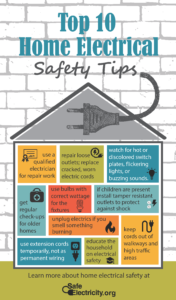Electrical Safety

We use electricity every day. This invisible force has become so commonplace that it can be all too easy to overlook possible electrical hazards, even in the safety of our own homes.
The Occupational Safety and Health Administration warns that electrical current levels as low as 3 milliamperes can result in injury. In a 2009 report on electrocutions associated with consumer products, the U.S. Consumer Product Safety Commission estimated an average of 70 fatalities per year (from 2007 to 2009). The most common product categories associated with these electrocutions were small appliances, large appliances, and power tools.

The following home safety tips are offered to help arm you with the knowledge to stay safe:
- Always read and understand the operator’s manual before using an appliance or tool.
- Make sure recognized safety laboratories, like UL, ETL, or CSA have certified the appliance, tools, and cords you will use.
- Never use a product with a damaged electrical cord.
- Never use extension cords on a permanent basis.
- Only use extension cords properly rated for the devices you plan to plug into it.
- For the safety of children in your home, install tamper-resistant outlets or protective coverings.
- If your outlets are warm to the touch, immediately shut them off at the circuit breaker, and contact a qualified electrician to make repairs.
- Install ground fault circuit interrupter (GFCIs) in areas that may be wet or damp. GFCIs help protect against electrical shock. Use the test and reset button monthly to ensure they are working properly.
- Never use power tools outdoors if it is raining or the ground is wet.
- If an appliance repeatedly blows a fuse, trips a circuit breaker, or has given you an electrical shock, immediately unplug it and have it repaired or replaced.





